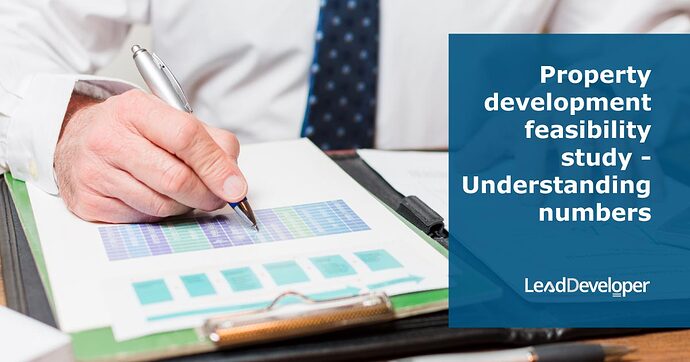Understanding Numbers
The article delves into the intricacies of financial feasibility in property development, emphasising the importance of thorough planning and analysis.
The content is structured around the concept of whether the end product of a development project can be sold at a predicted price after considering various financial aspects, including land acquisition costs, construction expenses, and eventual market value.
Financial Feasibility
The initial focus is on conducting a financial feasibility study to determine whether the numbers “stack up.” This entails evaluating whether the anticipated end sale price justifies the investment, including the cost of land and construction.
The study aims to ascertain a project’s viability and profitability, strongly recommending that it be based on current market conditions rather than speculative future values.
Key Participants
Financial feasibility can be conducted by individuals with a comprehensive understanding of the development process, including development managers, quantity surveyors, and architects. The importance of involving professionals with relevant expertise is underscored to ensure accurate and realistic financial projections.
Evolving Estimates
The video discusses the evolutionary nature of financial feasibility, where initial estimates are continually refined as more precise cost information becomes available. This process acknowledges the inherent uncertainties in early project stages and the need for adjustments as the project progresses.
Importance of Accurate Valuation
As explained in the video, accurately valuing the land and ensuring that construction and other associated costs align with market expectations play a significant role. Using a detailed example, it demonstrates how overpaying for land can significantly diminish or even negate project profitability.
Development Margin Analysis
The concept of development margin, or the profitability of a project, is explored through various scenarios. The video illustrates how different factors, such as an increase in land cost, can impact the development margin and, consequently, a project’s financial success.
Strategic Decision-making
Learn a “two-second feasibility” concept to quickly assess a deal’s potential before committing significant time and resources. This approach enables rapid evaluation of whether a project is worth further investigation based on preliminary financial indicators.
Comprehensive Feasibility Study Components
The video outlines the various components of a full-scale feasibility study, including land acquisition costs, finance costs, professional fees, construction costs, and selling costs. This comprehensive checklist serves as a guide for ensuring all critical aspects are considered in the feasibility analysis.
Insights based on numbers:
- Overpaying for land by even a tiny margin can significantly reduce the development margin, emphasising the need for precision in financial planning.
- The development margin is a critical indicator of project success. Various factors, including land cost and sale value, directly influence profitability.
- The “two-second feasibility” concept highlights the importance of swift, preliminary assessments in the decision-making process, allowing developers to identify viable projects quickly.
Frequently Asked Questions
How does the current market condition affect the financial feasibility of property development projects?
Market-Based Feasibility
The financial viability of a development project depends on the prices that the completed product can command in the current market. The study underscores the importance of aligning project costs, including land acquisition and construction expenses, with these market-driven sale prices to ensure profitability.
Risks of Speculation
The presenter warns against the temptation to base financial feasibility on anticipated market improvements. Speculating that the market will favorably adjust in the future to accommodate higher costs or to allow for increased sale prices can lead to significant financial misjudgments and potential project failure.
Importance of Realistic Assessments
The video illustrates the importance of realistic financial assessments using current market data. This includes evaluating comparable sales, understanding the current demand and supply dynamics, and accurately pricing the development in line with what the market can bear.
Adjusting to Market Fluctuations
It is highlighted that market conditions can change, and having a feasibility study that is flexible and adaptable to these changes is crucial. The feasibility must be revisited and adjusted as market conditions evolve to ensure the continued financial viability of the project.
What strategies can be employed to ensure accurate and realistic financial projections for a development project?
Engagement of Experts
One key strategy highlighted is the involvement of individuals with extensive knowledge of the development process, such as development managers, quantity surveyors, and architects. These professionals bring valuable expertise to the feasibility study, ensuring that all estimates are grounded in reality and reflect current industry standards and costs.
Evolutionary Approach to Estimates
Initial estimates are just that—estimates. They should be regularly updated as the project progresses and more accurate cost information becomes available. This approach acknowledges the inherent uncertainties in the early stages of project planning and allows for adjustments to be made as necessary.
Market-Based Valuations
Ensuring that financial projections are based on current market conditions is critical. This involves conducting market research to understand demand and supply dynamics, pricing structures, and comparable sales.
Using this data to inform the financial feasibility study helps prevent overestimations of sale prices and underestimations of costs, leading to more reliable and achievable financial goals.
Conservative Planning and Allowances
This includes making allowances for unexpected costs and ensuring that the project remains viable even if some variables do not perform optimally. By planning conservatively, developers can safeguard against overoptimism and ensure that the project remains financially feasible under a range of outcomes.
Continuous Re-evaluation
As the project develops, continuous re-evaluation of the financial feasibility is necessary. This means revisiting the feasibility study at key project milestones or responding to significant market changes. Adjustments should be made based on new information, ensuring the project remains on a sound financial footing throughout its development.
In what ways can overestimating the sale value of a development project impact its overall financial viability?
Reduced Profit Margins
Overestimating the sale value can lead to an unrealistic understanding of the project’s profitability. If the actual sale prices are lower than estimated, it can significantly reduce the profit margins, potentially turning a projected profit into a loss.
Feasibility Misalignment
The financial feasibility of a project is closely tied to accurate sale price estimations. Overestimation can lead to a feasibility study that appears positive but is not grounded in reality. This misalignment can result in financial commitments to projects that are not truly viable under current market conditions.
Budgeting and Financing Issues
Overestimating sale values can lead to unsustainable budgeting and financing strategies. Developers might find themselves in a situation where the revenue from sales does not cover the costs incurred during the development process, leading to potential financial distress.
Market Expectations and Pricing Strategy
The video stresses that sale values should be determined based on thorough market research, including demand and supply dynamics and comparable sales. Ignoring these factors and setting prices based on over-optimistic expectations can result in properties being priced out of the market, leading to extended sales periods or the need for price reductions.
Strategic Decision-Making Impact
An overestimation of sale values can influence strategic decisions in ways that compromise the project. For instance, developers might opt for higher specifications or more expensive materials in the belief that the market will support the resulting increased sale prices. The project may incur unnecessary costs without corresponding returns if this belief is unfounded.
What is financial feasibility in property development?
Financial feasibility is the evaluation process to determine whether a property development project is financially viable. This involves analysing whether the anticipated sale price of the developed property will cover the costs of land acquisition, construction, and other expenses, leading to a profitable outcome.
Why is conducting a financial feasibility study important?
Conducting a financial feasibility study is crucial to ascertaining the viability and profitability of a property development project. It helps developers understand whether their investment is justified based on the predicted sale price, ensuring that decisions are made based on current market conditions rather than speculative values.
Who should conduct a financial feasibility study?
A financial feasibility study should be conducted by professionals with a comprehensive understanding of the development process, such as development managers, quantity surveyors, and architects. Involving experts ensures that the financial projections are accurate and realistic.
How do estimates evolve in a financial feasibility study?
Estimates in a financial feasibility study evolve through the project’s life. Initially, estimates are rough and based on available data. Still, as the project progresses and more precise cost information becomes available, these estimates are refined to reflect the current reality, acknowledging the uncertainties in the early stages.
Why is accurate valuation important in property development?
Accurate valuation is critical because it ensures land acquisition, construction, and other associated costs align with market expectations. Overpaying for land or underestimating costs can significantly affect the project’s profitability.
What is a development margin, and why is it important?
The development margin refers to the profitability of a property development project. It’s a crucial indicator of success, affected by various factors such as land cost and sale value. A healthy development margin means the project is likely to be financially successful.
What is the “two-second feasibility” concept?
The “two-second feasibility” concept is a quick assessment tool that allows developers to evaluate a deal’s potential before investing significant time and resources. It enables rapid decision-making based on preliminary financial indicators, helping to identify viable projects quickly.
What are the components of a comprehensive feasibility study?
A comprehensive feasibility study includes various components such as land acquisition costs, finance costs, professional fees, construction costs, and selling costs. This checklist ensures that all critical aspects are considered in the feasibility analysis, covering the entire spectrum of expenses associated with the project.
How does overpaying for land affect a project’s development margin?
Overpaying for land can significantly reduce the development margin because it increases the initial investment required. This reduction in margin can jeopardise the profitability of the project, emphasising the need for precise financial planning.
How do various factors influence the development margin?
Various factors influence the development margin, including land cost, construction expenses, and the final sale value. Changes in any of these factors can impact the project’s profitability, making it crucial to estimate and manage costs accurately throughout the development process.
Test Your Knowledge
Multiple-Choice Questions on Understanding Numbers in Property Development
1. What is the primary purpose of a financial feasibility study in property development?
A) To design the architectural aspects of the development
B) To determine whether the project can sell at a predicted price covering all costs
C) To market the property to potential buyers
D) To secure construction permits from local authorities
2. Who are key participants in conducting a financial feasibility study?
A) Marketing agents and sales personnel
B) Development managers, quantity surveyors, and architects
C) Local government officials
D) Potential buyers and investors
3. How are initial estimates in a financial feasibility study handled as the project progresses?
A) They remain unchanged throughout the project
B) They are refined as more precise cost information becomes available
C) They are only updated at the end of the project
D) They are lowered to attract investors
4. Why is accurately valuing land crucial in property development?
A) It ensures compliance with zoning regulations
B) It affects the design of the development
C) It significantly impacts project profitability
D) It determines the marketing strategy
5. What is the significance of the development margin in property development?
A) It measures the environmental impact of the development
B) It indicates the project’s compliance with legal standards
C) It is a critical indicator of project success and profitability
D) It determines the timeline for project completion
6. What does the “two-second feasibility” concept allow developers to do?
A) Quickly assess a deal’s potential before investing significant resources
B) Determine the exact construction timeline
C) Calculate the precise sale price of the final product
D) Evaluate the architectural design of the project
7. Which of the following is NOT a component of a comprehensive feasibility study?
A) Color scheme of the development
B) Land acquisition costs
C) Construction costs
D) Selling costs
8. How can overpaying for land affect the development margin?
A) It has no effect
B) It increases the development margin
C) It significantly reduces the development margin
D) It only affects the construction timeline
9. Which factor does NOT directly influence the development margin?
A) The weather conditions during construction
B) Land cost
C) Sale value
D) Construction expenses
Answers
- B) To determine whether the project can sell at a predicted price covering all costs
- B) Development managers, quantity surveyors, and architects
- B) They are refined as more precise cost information becomes available
- C) It significantly impacts project profitability
- C) It is a critical indicator of project success and profitability
- A) Quickly assess a deal’s potential before investing significant resources
- A) Color scheme of the development
- C) It significantly reduces the development margin
- A) The weather conditions during construction
Assignment
Financial Feasibility Analysis in Property Development
Objective:
To demonstrate understanding of financial feasibility in property development by conducting a simulated feasibility study. This exercise will encompass the evaluation of land acquisition, construction expenses, market value, and other financial aspects crucial for determining a project’s profitability.
Instructions:
Case Study Selection
Select a hypothetical property development project. This could be a residential building, a commercial complex, or a mixed-use development. Provide a brief description of the project, including its location, size, and intended market segment (luxury, mid-range, affordable).
Land Acquisition Analysis
- Research the average cost of land in the selected location.
- Determine the size of the land required for your project.
- Calculate the total cost of land acquisition.
Construction Expense Estimation
- List the significant components of construction expenses (e.g., materials, labour, permits, and infrastructure).
- Estimate the cost for each component based on market rates or benchmarks from similar projects.
- Summarise the total construction expense.
Market Value Assessment:
- Conduct market research to determine the potential sale prices or rental rates for the type of development you are proposing.
- Consider current market conditions, demand, and supply in the area, and comparable sales or rentals.
- Provide a range for the anticipated sale price or rental rate per unit or square footage.
Financial Feasibility Study:
- Using the information gathered, construct a simplified financial model to evaluate the feasibility of the project.
- Calculate the total project cost by adding land acquisition and construction expenses.
- Estimate the total revenue based on the market value assessment.
- Determine the development margin and assess the project’s profitability.
Evolving Estimates and Risk Analysis:
- Discuss how your estimates might evolve as the project moves from planning to execution.
- Identify key risks that could impact the financial feasibility (e.g., increases in material costs, delays in construction, changes in market demand).
- Suggest strategies to mitigate these risks.
Two-Second Feasibility Test:
- Based on a preliminary assessment of costs and market value, conduct a “two-second feasibility” test to decide if further investigation into this project is warranted.
- Explain your reasoning.
Reflection and Strategic Decision-Making:
- Reflect on the importance of accurate valuation and realistic financial projections in property development.
- Discuss how strategic decisions made during the planning phase can impact the financial success of the project.
Research Questions:
- How do current market conditions affect the financial viability of property development projects?
- What are the consequences of overestimating the sale value or rental rates of a development project?
- How do professional roles (e.g., development managers, quantity surveyors, architects) contribute to the accuracy of financial feasibility studies?
To Do:
- Compile your analysis into a comprehensive report, including tables or charts to support your financial calculations.
- Ensure your report addresses each point listed in the instructions, clearly labeling each section for ease of reference.
- Conclude your report with a summary of your findings and a recommendation on whether to proceed with the development project based on its financial feasibility.
Submission Guidelines:
- Submit your report as a PDF or Word document.
- Ensure your work is well-organized, clearly written, and demonstrates a deep understanding of property development’s financial feasibility analysis process.
- Include any references or data sources you used for your market research and financial estimates.



